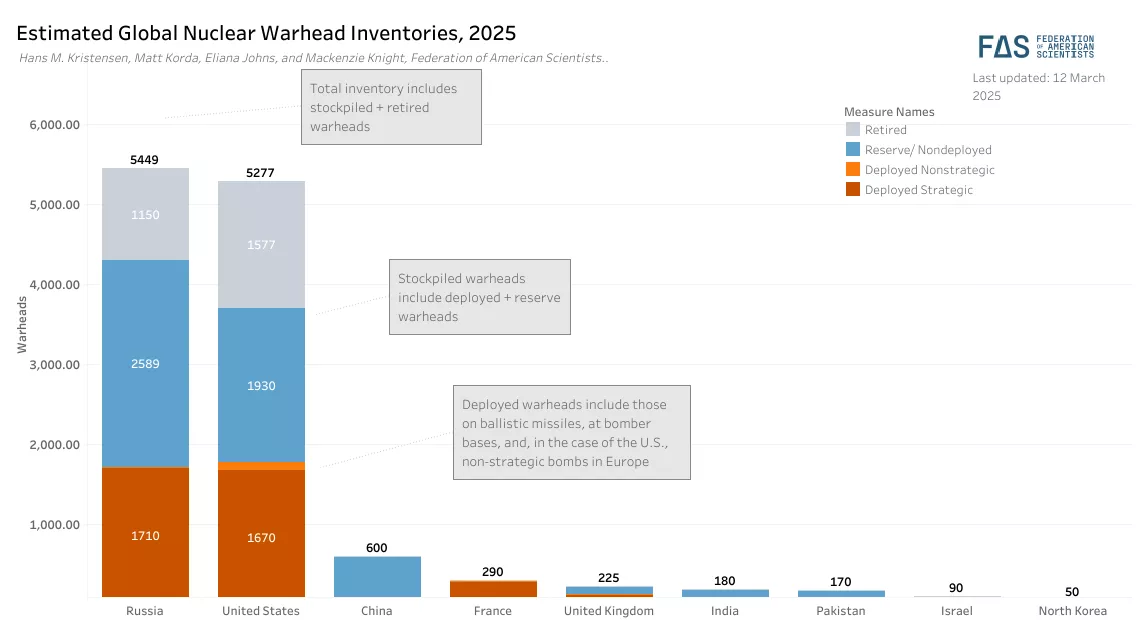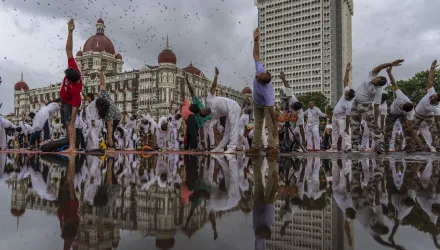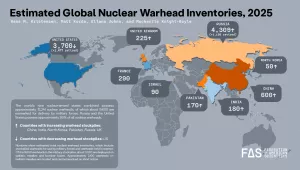- Multidomain warfare was at play between the two nuclear-armed neighbors. The 2025 crisis involved airstrikes, drones, cyber attacks, and naval maneuvers — a major escalation under the nuclear umbrella.
- India maintains a declared No First Use (NFU) policy. Pakistan pursues a full-spectrum deterrence posture aimed at deterring threats across the escalation ladder. These doctrinal asymmetries introduce challenges for crisis stability.
- Nuclear deterrence does not guarantee strategic stability. Despite deterrence and Confidence-Building Measures, modernization and high-alert postures mean there’s little margin for error in future conflicts.
- While the current crisis may be de-escalating on the surface, its long-term implications for crisis management, nuclear signaling, and regional diplomacy are profound. What happens next will shape not just South Asia's future but the evolving global understanding of nuclear deterrence in the 21st century.
Introduction
The 2025 India-Pakistan crisis has once again brought South Asia to the brink. Triggered by the April 22 attack in Pahalgam, Jammu and Kashmir, which killed 27 people, mostly tourists, the crisis evolved into a multidomain conflict involving airstrikes, missile exchanges, drone warfare, and cyber operations.
While both countries have avoided full-scale war, the events have underscored the fragility of deterrence and the inadequacy of existing escalation control mechanisms in a nuclearized environment.
A U.S.-brokered ceasefire announced on May 10 provided a temporary pause, but cross-border violations continue, and the risk of renewed hostilities looms.
This crisis reveals not only the structural instability of India-Pakistan relations but also the alarming normalization of limited military action under the shadow of nuclear deterrence.
A Primer on Kashmir
Kashmir remains at the heart of a decades-long territorial dispute between India and Pakistan, both of whom claim the region in full but control parts of the territory separated through a Line of Control. The disputed region of Kashmir has been the site of two wars between India and Pakistan pre-nuclearization in 1947–48, and in 1965. Since the 1998 nuclearization of both countries, major India-Pakistan crises, Kargil (1999), Indian parliament attack (2001), Mumbai attacks (2008), Pathankot (2016), and Uri (2016), have followed a pattern: India blamed Pakistan for terrorism and escalated through diplomatic or limited military means.
The 2019 Pulwama-Balakot crisis, in which 40 Indian paramilitary personnel were killed, marked a departure as India conducted an airstrike inside mainland Pakistan - signaling a shift toward unilateral preemptive action under the nuclear umbrella. After the 2019 crisis, on August 5th 2019, the Indian government unilaterally revoked Article 370, stripping Jammu and Kashmir (J&K) of its semi-autonomous status. The 2019 decision by India received intense disapproval from Pakistan since it violated UNSC resolutions, which demand a plebiscite to decide Kashmir's fate. Since 2019, the government of Pakistan has upheld its dismissal of the Indian action while maintaining that any modifications to Kashmir's status need to be discussed through multilateral talks and approved by the Kashmiri people.
After Article 370 was revoked, India established new domicile laws which Kashmiris see as a plan to change the population of the region. The indigenous freedom struggle has intensified because these actions are seen as a settler-colonial strategy by the Kashmiris. The Kashmiri people now fight to protect their identity together with their land and their right to self-determination. Both countries had tense bilateral relations with skirmishes along the line of control but a fragile ceasefire in 2021 had brought temporary peace.
The April 22, 2025 Pahalgam attack broke the ceasefire.
Unraveling the Crisis: Strikes, Signals, and Strategic Messaging
The Pahalgam attack on April 22, which was first claimed and later disavowed by a little known militant outfit, The Resistance Front, triggered a cascade of diplomatic and military escalations. India swiftly blamed Pakistan for the attack, aligning with a familiar playbook that outsources its own internal security failures largely on to Pakistan. Pakistan rejected the Indian allegations, framing the attack as a false flag operation orchestrated to justify India’s coercive action. No evidence was shared with Pakistan or with the international community about the perpetrators of Pehalgam who are still at large. Reciprocal diplomatic expulsions from each other’s countries, Indian announcement of the suspension of the Indus Waters Treaty, and military mobilization, followed after the blame on Pakistan.
Named Operation Sindoor, India carried out missile strikes inside Pakistan on May 6-7, marking significant intensification. Involving Rafale jets armed with SCALP missiles and Hammer bombs, the strikes targeted alleged terrorist infrastructure in several cities in Punjab and Azad Jammu & Kashmir. India claimed the killing of over 100 militants in its strikes while Pakistan reported 31 civilian casualties, including women and children.
This pattern mirrors the 2019 Balakot episode, but with far higher stakes and expanded domains of engagement by both sides. Pakistan launched Operation Bunyan-un-Marsoos with retaliatory strikes not only through conventional means, missiles and drones, but also across the cyber and informational spectrum, mirroring and countering India’s offensive measures, including cyber operations and naval signaling in the Arabian Sea. Multidomain warfare was at play between the two nuclear-armed neighbors.
The 7th May 2025 aerial engagement between the two countries marked an unprecedented moment in the entire history of the nuclear age: the first-ever jet-era dogfight between two nuclear-armed states. In a highly compressed battlespace, more than 40 Pakistani fighters including JF-17 Thunders, J-10Cs, and F-16s, confronted more than 80 Indian aircraft, among them Rafales, Su-30MKIs, and MiG-29s. Both sides operated with real-time data from AWACS and employed long-range air-to-air missiles like the PL-15. The clash resulted in the downing of five Indian aircraft, illustrating how quickly escalation can spiral in a nuclearized environment where the margin for error is vanishingly small.
The fog of war thickened with both sides claiming victory. Unverified claims of downed jets and media disinformation, underscored how perception management now plays as much a role as kinetic action.
In a nuclear dyad where both sides have assured capabilities, the most effective deterrent is to refrain from an immediate and impulsive response.
The Nuclear Dimension
The 2025 crisis cannot be understood without acknowledging the nuclear backdrop that shapes every Indian and Pakistani crisis. Both countries possess nuclear arsenals that are designed to deter full-scale all-out conventional wars, but with sharply contrasting doctrines and postures.
Nuclear Capabilities in the Shadow of Escalation
According to FAS estimated Global Nuclear Warhead Inventories 2025 both India and Pakistan maintain nuclear arsenals estimated at approximately 180 and 170 warheads respectively, but their doctrines and force structures differ markedly.

India has a declared No First Use (NFU) policy coupled with a doctrine of massive retaliation. However, post-2019 political rhetoric has cast doubt on the credibility of its NFU commitment. India continues to invest in modernization, developing multiple independently targetable reentry vehicles, commissioning its second nuclear-powered ballistic missile submarine, and operationalizing delivery platforms such as Rafale jets and Agni-V missiles. These moves underscore a shift toward a more flexible and survivable second-strike capability, though India still lacks the operational redundancy of more mature nuclear powers.
In contrast, Pakistan adheres to a full-spectrum deterrence posture aimed at offsetting India’s conventional advantage at every level of conflict. This includes tactical nuclear weapons like the Nasr, medium-range systems such as Shaheen-II, and dual-capable platforms including Babur cruise missiles and PL-15-equipped J-10Cs. Pakistan's doctrine emphasizes calibrated escalation to prevent strategic surprise as was witnessed in this ongoing crisis. While neither country has signaled a shift to elevated nuclear alert status during the current crisis, Pakistan’s invocation of Article 51 and Indian strikes on sensitive sites have pushed the region perilously close to the edge.
Ceasefire or Pressure Valve?
The U.S.-brokered ceasefire on May 10 is a welcome pause, but its fragility is evident. Violations continue along the Line of Control, and political narratives on both sides remain uncompromising. India’s silence on U.S. mediation, contrasted with Pakistan’s acknowledgement, reveals domestic political constraints particularly for the Modi government, which thrives on hardline nationalism.
The crisis has entered what may be termed escalation gone meta where each retaliatory move becomes a response not just to the last strike, but to an entire historical narrative of mistrust. Breaking this cycle requires more than a ceasefire, it demands a rethinking of regional stability mechanisms.
Conclusion
Despite the intensity of the 2025 crisis, the India-Pakistan Agreement on the Prohibition of Attack against Nuclear Facilities, signed in 1988 and reaffirmed annually, has held firm. This long-standing confidence-building measure (CBM), which mandates both sides to exchange lists of nuclear installations every January 1st, has thus far prevented direct strikes on declared nuclear sites, even amid escalatory pressures and targeted attacks on adjacent strategic infrastructure during this current crisis.
However, the 2025 India-Pakistan crisis is a stark reminder that nuclear deterrence does not guarantee strategic stability. As both sides experiment with new tools of warfare, drones, cyber, precision missiles, the risk of miscalculation multiplies. The concept of fighting a limited nuclear war between India and Pakistan is a dangerous illusion. Given the compressed geography, high alert postures, and the logic of full-spectrum deterrence, there is virtually no escalatory buffer, no meaningful space to fight and contain conflict once thresholds are crossed.
While the current crisis may be de-escalating on the surface, its long-term implications for crisis management, nuclear signaling, and regional diplomacy are profound. While the ceasefire holds for now, its permanence is far from guaranteed in a region where unresolved tensions simmer just beneath the surface.
What happens next will shape not just South Asia’s future but the evolving global understanding of deterrence in the 21st century.
Statements and views expressed in this commentary are solely those of the authors and do not imply endorsement by Harvard University, the Harvard Kennedy School, or the Belfer Center for Science and International Affairs.
Akhtar, Rabia. “Escalation Gone Meta: Strategic Lessons from the 2025 India-Pakistan Crisis.” May 14, 2025




